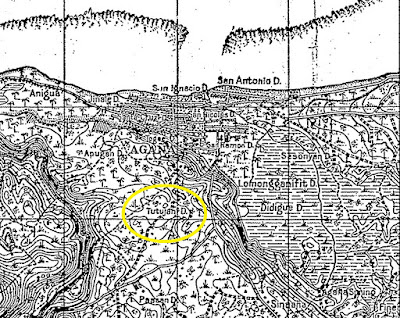This is a story with a moral, a lesson in right behavior. The moral of this story is : Be generous. God punishes the selfish and takes away what they had.
Ginen guaha taotao ni gai iyo dångkulo yan lokka' na
trongkon mångga.
(There was once a man who owned a large and tall mango tree.)
Fuera de i dinangkulo-ña yan linekkå'-ña, sen meppa' na
trongkon mångga.
(Besides its size and height, the mango tree was very fruitful.)
Kada såkkan sen bula tinekchå'-ña mångga, asta ke ini'ingak
påpa' i ramås-ña
(Every year it had a lot of mango, till its branches bent down)
kulan mohon para u pacha i edda'.
(as if to touch the ground.)
Mamopoddong i mångga yan meggai na fruta man låstima sa' ti
man ma hokka'
(The mangoes would fall and much fruit was wasted because they wouldn't be picked up)
ya ti man ma kånno'.
(and wouldn't be eaten.)
Un dia, maloffan un sottero gi me'nan este na trongko ya ha
repåra
(One day, a young man passed in front of this tree and noticed)
na man låstima i mångga ni esta man lamas gi hilo' odda' sa'
ti man ma hohokka'.
(that the mangoes were wasted as they ripened on the ground because they weren't picked up.)
Umessalao para u yåma i dueño ni pine'lo-ña na eståba gi
halom guma'
(He yelled to call the owner whom he supposed was inside the house)
lao ti humuyung i dueño.
(but the owner didn't come out.)
Entonses, ha tutuhon i sottero måmfe' mångga ginen i mas
manakpapa'
(Then, the young man began to pick mangoes from the lowest)
na råmas ni man libiåno ma tife'.
(branches which were easy to pick.)
Gigon ha tutuhon måmfe', humuyung i dueño ginen i gima'
(When he started to pick, the owner came out of the house)
ya ha tutuhon lumalåtde i sottero ya ha dulalak.
(and started to scold the young man and chase him away.)
Må'pos i sottero sin håfa na mångga ya asta ke måkpo' i
tiempon mångga,
(The young man left with no mangoes at all and till mango season was over,)
i dueño ti ha sedi ni håyeye para u fånfe' mångga ginen i
trongko-ña,
(the owner didn't allow anyone to pick mangoes from his tree)
achok ha' meppa' ya man lålåstima i mångga.
(even though it was abundant and the mangoes were being wasted.)
Gi sigiente na såkkan, annai esta måtto i tiempo ni para u
fanflores i
(The following year, when it came time for mango trees to flower,)
trongkon mångga, ma repåra nu i taotao na i mamalo na trongkon
mångga
(people noticed that the other mango trees)
manfloflores, lao i trongkon mångga ni iyon i chattao na
dueño tåya'
(were flowering, but the mango tree of the stingy owner)
flores-ña. Annai esta bula tinekcha'-ñiha i mamalo na
trongkon mångga,
(had no flowers. When the other mango trees had a lot of fruit,)
ayo na trongko ni iyon i chattao na taotao, sen taya' tinekchå'-ña
mångga.
(that tree owned by the stingy man was really lacking mango fruit.)
Mina' i chinattao-ña i dueño na si Yu'us ha kastiga ayo na
taotao
(It was due to his selfishness that God punished that man)
ya ti ha na' gai tinekcha' i trongko-ña.
(and didn't make his tree bear fruit.)















